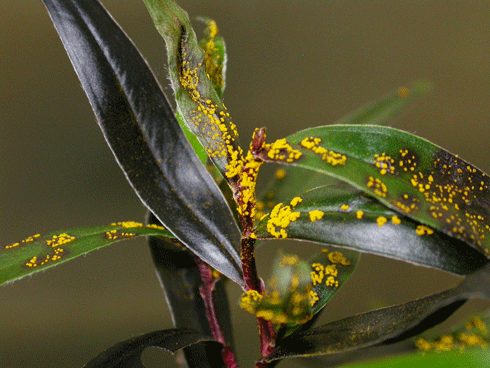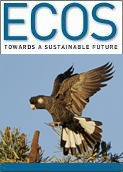
|
Published: 21 June 2013
Whatever happened to myrtle rust?
It was the disease plant biologists in Australia had been expecting with trepidation. In April 2010, a type of rust that had been threatening eucalypt plantations overseas was found dusting a plant leaf in a New South Wales nursery.

|
|
Various stages of myrtle rust disease development on the Western Australian species, Agonis flexuosa (willow myrtle). Credit:
Louise Morin
|
Environmentalists predicted the rust’s spread would become a ‘mycological firestorm’. But three years on ECOS asks, has it been more of a fungal fizzle?
The plant pathogen, often referred to as guava rust, has long had something of an identity crisis. In its native Brazil, the fungus was named after its original host plant.
Yet this fungus, Puccinia psidii, doesn’t just attack guava – a tree that belongs to the Myrtaceae family. Melaleucas, eucalypts and other trees from the same family have proved equally suitable host plants overseas, with the pathogen infecting developing foliage, flowers and fruits and stunting growth.
As a result, P. psidii has also become known as eucalyptus rust, and recognised as a threat to eucalypt plantations across the globe, not to mention native Australian flora.
Apart from its variable common name (guava/eucalypt rust), the rust has had mycologists debating whether a second rust species might be involved. In the early 1980s, a reference specimen representing P. psidii was discovered to contain two different kinds of spores, one ‘prickly’ all over, while the other presented a bald patch among its protuberances. This prompted mycologists to describe the rust taxonomically as a ‘complex’ of biological forms.
Three decades later, the form that produced the bald-patch spores was given the name Uredo rangelii. This was the form that was found in Australia in 2010 and referred to as myrtle rust.
Today, it still remains unclear whether the complex of forms should be considered as a group of distinct species or merely varieties, in spite of no genetic differences being found between the forms. Until such questions are resolved, the pathogen continues to be technically defined as Puccinia psidii sensu lato (s.l.).
How big a threat?
Whatever its identity, the rust of many names has been threatening to become a pathogen of many hosts. Recent studies1 indicate that, given the right conditions, P. psidii (s.l.) has the potential to infect all members of the subfamily Myrtoideae within Australia’s native myrtle family.
Given myrtles make up ten per cent of Australia’s flora, it’s no wonder the appearance of the fungus in NSW in 2010 was seen as a potential disaster for many of our wooded ecosystems.
In fact, within two years of the pathogen’s arrival, scientists had identified 175 plants as potential hosts. Of these, only a third were yet to present infected specimens in the wild. But while the pathogen’s reach across the myrtle family is broad, its impact remains unclear.
Dr Louise Morin from CSIRO Ecosystem Sciences has studied the rust’s host-specificity and life cycle. ‘Unfortunately, as far as I know there hasn’t been comprehensive research to assess the impact of the rust on plant populations,’ she says.
‘There has been some work that showed a reduction in various growth and reproduction parameters on some species, but nothing yet to assess if such reduction will affect populations of these species in the long term.’
A 2012 report by the CRC for Plant Biosecurity on the impact of myrtle rust provides a preliminary glimpse of the rust’s spread, but also concludes with a recommendation for more research to gain a clearer picture. 2
‘Given the observed impacts of myrtle rust in Australia within the first two years since the disease was initially detected,’ the report states,‘[such] research is critical to minimise the impacts of this disease incursion on plant industries, the environment and communities in Australia.’
Myrtle rust has been discovered on a variety of plants along the east coast, from Queensland through New South Wales and Victoria. While conditions in Tasmania and Western Australia are suitable for its proliferation, the two states have so far remained unblemished by P. psidii (s.l.) spores.
That’s not to say there’s no heat in this brushfire. Now established on Australian soil, it’s merely a matter of time before the pathogen finds its way into suitable ecosystems across the continent.
To identify potential hotspots for P. psidii (s.l.) epidemics in Australia, CSIRO researchers worked with colleagues from the University of Hawaii to combine modelling with known distributions of myrtle species.3
The results predict a greater degree of cold tolerance in the rust than previously believed, expanding its range to higher altitudes and lower latitudes. So while Australian species may be indicating tolerance for the pathogen, any restrictions imposed by cooler climates could be less severe than initially anticipated.
On mainland Australia, this may not be significant. ‘According to our unpublished modelling results, the potential range of P. psidii (s.l.) is likely to contract toward the coasts as the climate in central Australia warms and dries,’ says CSIRO Ecosystems Science principal research scientist, Dr Darren Kriticos.
If – or even when – it reaches Tasmania, it might be a different story. ‘In Tasmania and New Zealand it appears as if it could expand its potential range significantly compared with the present situation,’ Dr Kriticos suggests.
Looking for the right clues?
Since 2010, the Australian Government has invested about $1.5 million into a ‘Myrtle Rust Transition to Management Program’. While this funding has led to some insight into the pathogen’s potential range, some have questioned whether enough action has been taken address the threat.
Last year, Invasive Species Council CEO John DeJose stated, ‘The failure of our national biosecurity system to quickly detect and appropriately respond to the extreme risks posed by myrtle rust now has scientists concerned about the level of government commitment to keeping Australia free of harmful environmental pests.’
But, three years after its first appearance, hard evidence of the devastation myrtle rust can cause to Australia’s ecosystems remains scant.
‘Maybe one of the reasons we haven't [identified any] serious impact of the rust yet is the fact that hardly anyone is looking at its impact in ecosystems,’ suggests Dr Geoff Pegg, Senior Forest Pathologist at the Department of Agriculture, Fisheries & Forestry in Queensland.
‘I think most people expected to see vast areas of dead trees. But we [the researchers] have always believed most of the impact will be in relation to regeneration of species.’
If that’s the case, it could be years before the true impact of myrtle rust is observed in the field. Already scientists have noticed flower growth can be impeded in trees with repeated stem infections.
Further, species that have been recorded as relatively tolerant are now showing evidence of being highly susceptible. Why? ‘Hard to answer this one at this point in time,’ says Dr Pegg.
Renewed funding will be required for future research into the pathogen’s spread through Australia. The government’s Myrtle Rust Transition to Management Program is scheduled to conclude at the end of June 2013, with little prospect of further funding beyond that.
1 Morin L, Aveyard R, Lidbetter JR, Wilson PG (2012) Investigating the host-range of the rust fungus Puccinia psidii sensu lato across tribes of the family Myrtaceae present in Australia. PLoS ONE 7(4): e35434.
2 Cooperative Research Centre for National Plant Biosecurity, Final Report CRC 70186, Understanding myrtle rust epidemiology and host specificity to determine disease impact in Australia, Geoff Pegg, Suzy Perry, Angus Carnegie, Kylie Ireland and Fiona Giblin.
3 Kriticos DJ, Morin L, Leriche A, Anderson RC & Caley P (2013) Combining a climatic niche model of an invasive fungus with its host species distribution to identify risks: Puccinia psidii sensu lato in Australia. PLoS ONE 8, e64479.



